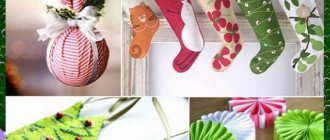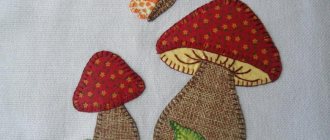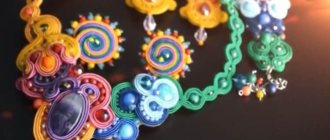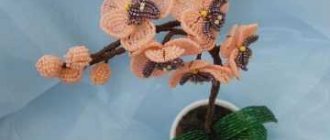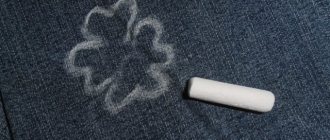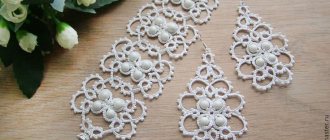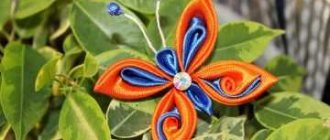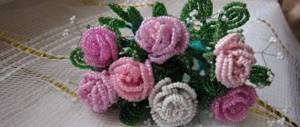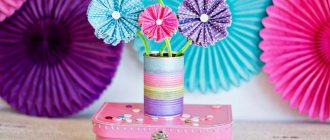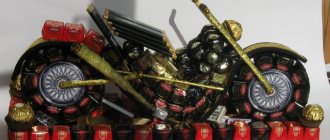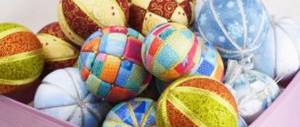Materials and tools
Before starting the embroidery process itself, it is worth preparing the necessary accessories used in the work. You need to get needles with large eyes (special embroidery, tapestry), into which ribbons can pass unhindered. You will need a hoop to tension the fabric and make work easier (regular round ones, snappy square ones). The material plays an important role for the future composition. It should not be dense; it is best to choose gabardine, linen or ready-made prints with a printed composition. And most importantly, you need to choose the right tapes, of which there are a lot. It is better for beginning needlewomen to use satin ribbons in the initial stages; with practice, you can include organza and silk. You will also need paints for tinting, a lighter or candle, scissors, fabric outlines, modeling gel, a disappearing marker for drawing, floss and iris.
LiveInternetLiveInternet
Natural silk ribbons are deservedly considered the best material for ribbon embroidery. Amazing softness and silkiness, on the one hand, and the ability to obtain any shades of color using both factory and hand-dying, on the other, distinguish this material from the incredible variety of synthetic substitutes presented in sewing and handicraft stores. However, natural silk ribbons are quite expensive and therefore are rarely found on sale here. But don't despair: synthetic ribbons also work well for embroidery, especially if they are first washed in warm water and a mild detergent. When choosing single-color ribbons with satin and matte textures, do not ignore elegant braid made of organza and other materials - it will help diversify your work and achieve amazing decorative effects.
Be careful! Ribbons of some colors, such as bright red and burgundy, need to be wetted before work so that stains and stains that may appear on the fabric during work do not spoil the embroidery.
Embroidery ribbons come in different widths - from 3 to 12 mm. Thinner ribbons are easier to pass through the fabric, so they are more often used in the actual embroidery technique. Beautiful overhead elements are made from a wide ribbon - flowers, bows, which are sewn to the work with invisible stitches, using thin threads to match the ribbon. By combining ribbon with traditional embroidery threads, you can get a very original embroidery. For work, it is better to use ribbons and braid no longer than 50 cm so that they do not curl. If this does happen, just lower the needle down perpendicular to the floor, and the tape will unwind itself. As a basis for ribbon embroidery, you can use a wide variety of fabrics from cotton (matting, cambric, muslin, satin, corduroy), linen (canvas, linen), silk (chiffon, tulle, cardigan), wool (crepe, tweed, jersey). To master the technique, you can use regular Aida canvas and evenly woven cotton and linen fabrics, the main thing is that the fabric is strong and elastic enough for the ribbon to pass through it easily. Use not only plain-dyed, but also printed fabrics: their design can suggest to your imagination the theme and plot of the embroidery. Plain fabrics, as well as ribbons, can be dyed at home, using special acrylic paints, which are fixed by ironing (if the embroidered work will be washed), or ordinary watercolors - for embroidered paintings that will be exhibited in a frame under glass . The success of your work largely depends on your sewing needle. If you are embroidering on loosely woven or knitted fabrics, use tapestry needles that have a blunt tip. In other cases, chenille needles with a sharp tip and a long eye are better suited for threading ribbons of different widths. Beginners (and not only) needlewomen will especially find hoops or special frames for stretching the base for embroidery. A needle and ribbon can pass through a tightly stretched fabric more easily, and the work will not be deformed or wrinkled, so after finishing the work, you just need to iron the edges of the embroidery, just in case - from the wrong side.
The hoops that make up the hoop are designed to ensure that the fabric is well stretched during operation. This ensures even stitches. This way, even someone who has a tendency to tighten the stitch will not be able to pull the ribbon too tight, so the embroidery will turn out voluminous. Hoops are available in different sizes. In this hoop, one hoop is put on another and tightened with a side screw. Round hoops are usually used for small embroidery projects. They are very convenient and easy to assemble. Lay the fabric over the smaller hoop and place the second hoop on top. Tighten the screw until the fabric is taut. Do not tighten the fabric after tightening the large hoop.
How to wrap a hoop.
To make a hoop consisting of two hoops, take a soft braid and wrap one of the hoops around the circumference. Stretch the braid so that no folds form. When the hoop is completely wrapped, secure the ends of the braid with small stitches. Wrap the second hoop. If you don’t have any braid at hand, you can use thin and narrow bandages. Wrapping a round hoop is an operation that helps to avoid the appearance of creases on such light fabrics as silk, organza or velvet when flattened, which will then be difficult to get rid of.
| To begin with, you will need a few basic colors, because most shades can be obtained simply by mixing them. Buy silk paints for dyeing the ribbon in dark blue, dark red and purple, from which you will get a wonderful purple shade, and two yellow ones - just yellow to make a bright green shade, and light yellow to get a swamp. In addition, I sometimes use raspberry color. For fabric paints, I choose dark red, regular yellow and light yellow, red and cobalt. Very often, to get the desired color, I mix silk and fabric paints: for example, if you mix dark blue silk paint with yellow fabric paint, you get a rich green color. I also note that how it will be applied to the fabric depends on the thickness of the paint. Fabric paint is great for adding crisp, patterned lines to fabric and fine speckles on petals and leaves. Don't forget to test the dye on an extra piece of silk ribbon first. Gutta is a kind of barrier that prevents the paint from spreading, but makes it difficult to draw very fine lines. You will also need a smooth white ceramic tile and a white plate or saucer where you will mix the paint; Paint brushes, including a small to medium-sized hard flat brush. You also need thin and medium round brushes. A hairdryer can dry the paint much faster, which will prevent it from bleeding onto the tape or fabric. Small pieces of sponge are perfect for lightly painting the base of the foliage; instead, you can use a small piece of regular rope. Don't be afraid to experiment! And of course, remember to always check the colors before applying paint to the fabric or tape; You will always have time to make the color more saturated. |
Threads
You will need a set of embroidery thread to sew the ribbons onto the fabric, gather them and form the stem and inflorescence. The most important thing is to use threads that match the fabric. In addition, it is necessary to select threads of the appropriate color for the ribbons. Also, other threads of various thicknesses and textures are used to create stems and inflorescences, such as perle, broder, braid, as well as strands of wool and leather straps.
Bell. Step by step lesson
A delicate, beautiful flower will look great as a separate picture, as a decorative element and will combine well with other flowers. The author of the lesson will show 3 simple ways to embroider bells. The first shows the process of creating a bud, using several techniques: a French knot that gives volume to the flower at the base, a straight stitch that creates petals and a covering knot. The second is a flower with stamens made with a French knot on the stem. The third option is a more complex, voluminous flower created by placing several rows of ribbons on top of each other.
Miniature flower arrangement
Video of a master class on embroidering a small composition that will look good in decorating home textiles. It is composed of several types of flowers and herbs. The work is done in blue, red and olive colors, with the addition of white yarn, threads and beads. First you need to draw a sketch of the future painting. Each element of the design is embroidered separately using different techniques to complete them. The author will tell you in detail which techniques are appropriate to use and what effect you can get from them.
Frames for embroidery with ribbons
Beautiful rosebuds, like all other images, after decorating the reverse side, need to be framed in order to find them a worthy place in the room. Paintings created using silk ribbons are recommended to be placed in original frames. It is best to order from framing workshops. The master knows exactly in which frame the drawing will be more attractive and will look original and sophisticated.
This popular embroidery can also be decorated using ready-made frames. The main thing is to adhere to a number of recommendations when choosing them. In order for the result to exceed all expectations, the following points deserve attention:
- It is recommended to give preference to frames without glass. In them the picture looks much more impressive. In addition, it turns out to be voluminous, but under glass it will not be noticeable.
- Regardless of whether you were embroidering daisies or any other images, wooden frames would be an excellent solution. They will match the color scheme of the finished product and fit harmoniously into the overall interior.
- A beautiful flower can also be framed in a more original frame. The main thing is that its shades match the created picture.
- It is unacceptable for the frame to distract attention from the work itself. In this case, images even with the most beautiful buds do not look so attractive. Therefore, preference should be given to simple products.
By following these recommendations, the effect of ribbon embroidery will be amazing. No one can ignore her.
Volumetric cornflowers
Cornflowers can be included in a combined bouquet or made into a separate composition. For a bouquet of cornflowers you need ribbons of green, lilac or purple in different shades, and threads for the center. The master class will help beginners master cornflower embroidery. It will be presented in 3 types: open with stamens, turned to the side, closed bud. They are made with a straight seam, using ribbons of different tones to create volume. The stems are made using twisted tape, which is then sewn on with thread. Leaves can be embroidered using any convenient method.
Knitted toys - patterns
—Tags
—Categories
- Style, fashion (133)
- Antiques (2)
- books (2)
- how to earn money (1)
- Interiors (180)
- Hand-made/ideas (211)
- brands (41)
- interesting (266)
- thoughts out loud (5)
- positive (21)
- SOS (59)
- cars (33)
- Author's works (131)
- Architecture (18)
- BUSINESS (219)
- VIDEO (221)
- knitting (937)
- Cities and countries (70)
- dacha (51)
- FOR BLOGGERS (17)
- for diary (16)
- for the soul (65)
- Homemade cosmetics (118)
- domain and hosting (10)
- LIFE in all its manifestations (30)
- read magazines and books online (124)
- make money on the Internet (255)
- games, entertainment (206)
- internet (99)
- art (37)
- History of things (29)
- computer (29)
- copywriting (10)
- landscape design (22)
- Liru (10)
- affiliate (26)
- Useful programs and services for webmasters (39)
- useful tips (715)
- for motorists (13)
- for home (161)
- pets (4)
- internet (38)
- beauty, health (180)
- kitchen (42)
- education (12)
- rest and holiday (47)
- travelers (17)
- work (24)
- miscellaneous (50)
- parents (37)
- tips for summer residents (28)
- Tips for needlewomen (69)
- legal (18)
- Holiday date (314)
- May 9. Victory Day (6)
- May 1 (2)
- February 23 (7)
- March 8 (18)
- Birthday (44)
- valentine's day (34)
- New Year! (203)
- Easter (44)
- Wedding (33)
- bells and whistles (46)
- products (691)
- pizza (13)
- sweets (57)
- Pancakes, pancakes (26)
- blanks (118)
- cupcakes, gingerbreads, cookies, pastries (94)
- smoking (8)
- dairy products (10)
- meat products (72)
- dumplings, dumplings, khinkali (13)
- Salad Recipes for Sale (20)
- fish (33)
- sushi, rolls (2)
- cheese (19)
- cakes (133)
- bread (67)
- chebureks, belyashi, pies, khachapuri (39)
- kebab (30)
- SITE PROMOTION (69)
- crafts and various techniques (51)
- Scandals (5)
- download (1320)
- Scrap kits (13)
- Website creation (37)
- Social networks (13)
- WAYS TO EARN (145)
- TECHNOLOGY FOR MANUFACTURING BOUQUETS FROM CANDY. (17)
- DRAWING SCHOOL (9)
- Hair salon-at-home (2)
- BONSAI - do it yourself (1)
- Holiday decoration (1)
- airbrush (3)
- manicure (22)
- gift decoration (67)
- Tattoo (2)
- FLORISTRY (14)
- ways to make money at home (1531)
- wedding accessories (29)
- DIY cards (2)
- Batik (any designs on fabric) (14)
- felting (36)
- Stained glass painting (13)
- Mushroom cultivation (8)
- embroidery (231)
- Ribbon embroidery (64)
- mobile phone decor (3)
- Decoupage (93)
- make candles (32)
- Home floriculture (11)
- DIY toys (158)
- from newspapers (1)
- made of wood with your own hands (12)
- cardboard (9)
- felt (7)
- Making jewelry (master classes) (68)
- Bead products (193)
- leather goods (21)
- isothread (2)
- Kanzashi (2)
- carving (6)
- Carnival costumes (31)
- quilling (18)
- forging, blacksmithing (2)
- Craquelure (1)
- DIY dolls (113)
- Modeling from clay (36)
- Making from salt dough (15)
- plastic modeling (8)
- macrame (26)
- papier mache (6)
- weaving (14)
- patchwork (147)
- Painting (15)
- scrapbook (69)
- Jewelry (176)
- Cold porcelain (12)
- labels, packaging (14)
- LINKS (186)
- FARMING (10)
- Quail farming (2)
- Goats - sheep - rams - Breeding and keeping (1)
- Keeping cows on a private farm (1)
- photos (12)
- photoshop (17)
- Raster cliparts (3)
- Sewing (351)
- e-wallet (26)
- humor (47)
Garden daisies
Daisies will perfectly decorate pillows, clothes and will look good against a colored background. A lesson from a master for needlewomen with little experience will help you learn the technique of making this flower. We use 6 mm white and green tape, a piece of velvet for the middle, colored fabric, and acrylic paints for tinting. Everything is very simple: the stitches are made from the center to the edge, and then from the edge to the center, where they are more tightly gathered, then the actions are repeated and so on in a circle. At the end, a core of velvet fabric is sewn on. To give the chamomile a more vibrant look, its petals can be slightly tinted with paint.
